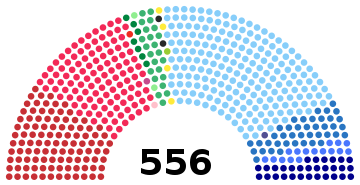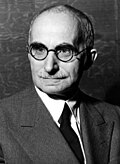| |||||||||||||||||||||||||||||||||||||||||||||||||||||||||||||||||||||
556 of the 573 seats in the Constituent Assembly 279 seats needed for a majority | |||||||||||||||||||||||||||||||||||||||||||||||||||||||||||||||||||||
|---|---|---|---|---|---|---|---|---|---|---|---|---|---|---|---|---|---|---|---|---|---|---|---|---|---|---|---|---|---|---|---|---|---|---|---|---|---|---|---|---|---|---|---|---|---|---|---|---|---|---|---|---|---|---|---|---|---|---|---|---|---|---|---|---|---|---|---|---|---|
| Registered | 28,005,449 | ||||||||||||||||||||||||||||||||||||||||||||||||||||||||||||||||||||
| Turnout | 89.08% | ||||||||||||||||||||||||||||||||||||||||||||||||||||||||||||||||||||
| |||||||||||||||||||||||||||||||||||||||||||||||||||||||||||||||||||||
  On the left, results of the election by province. On the right, the seat distribution by constituency. On the left, results of the election by province. On the right, the seat distribution by constituency. | |||||||||||||||||||||||||||||||||||||||||||||||||||||||||||||||||||||
| |||||||||||||||||||||||||||||||||||||||||||||||||||||||||||||||||||||
General elections were held in Italy on Sunday 2 and also on Monday 3 June (but until noon) 1946. They were the first after World War II and elected 556 deputies to the Constituent Assembly. Theoretically, a total of 573 deputies were to be elected, but the election did not take place in the Julian March and in South Tyrol, which were under military occupation by the United Nations.
For the first time, Italian women were allowed to vote in a national election and run for a seat in the Constituent Assembly.
This election was held concurrently with the 1946 Italian institutional referendum on the abolition of the monarchy.
Electoral system
To emphasise the restoration of democracy after the fascist era, a pure party-list proportional representation was chosen. Italian provinces were united in 31 constituencies, each electing a group of candidates. At constituency level, seats were divided between open lists using the largest remainder method with the Imperiali quota. Remaining votes and seats were transferred at national level, where special closed lists of national leaders received the last seats using the Hare quota.
Campaign
At the end of World War II, Italy was governed under transitional laws as a result of agreements between the National Liberation Committee (CLN) and the royal Lieutenant General of the Realm Umberto II of Italy. As no democratic elections had taken place for more than 20 years, legislative power was given to the government but, after the first election, the Italian Council of Ministers would have to receive a vote of confidence by the new Constituent Assembly.
The three main contestants were Christian Democracy and the Italian Socialist Party, which had both received popular support before the fascist era, and the Italian Communist Party, which had strengthened itself with the armed struggle against Nazism and fascism during the war. The Italian Liberal Party, heir of the pre-fascist and conservative ruling class, proposed an alliance called National Democratic Union. Monarchists groups created the National Bloc of Freedom, while the liberal socialist Action Party and Labour Democratic Party hoped to maximize the positive image of the governments that they ruled in the National Liberation Committee.
Parties and leaders
Results
The election gave a large majority to the government formed by the three leaders of the CLN, which was briefly joined by the Republican Party after the exile of Umberto II. The alliance lasted for a year.
 | ||||
|---|---|---|---|---|
| Party | Votes | % | Seats | |
| Christian Democracy | 8,101,004 | 35.21 | 207 | |
| Italian Socialist Party of Proletarian Unity | 4,758,129 | 20.68 | 115 | |
| Italian Communist Party | 4,356,686 | 18.93 | 104 | |
| National Democratic Union | 1,560,638 | 6.78 | 41 | |
| Common Man's Front | 1,211,956 | 5.27 | 30 | |
| Italian Republican Party | 1,003,007 | 4.36 | 23 | |
| National Bloc of Freedom | 637,328 | 2.77 | 16 | |
| Action Party | 334,748 | 1.45 | 7 | |
| Movement for the Independence of Sicily | 171,201 | 0.74 | 4 | |
| Peasants' Party of Italy | 102,393 | 0.44 | 1 | |
| Republican Democratic Concentration | 97,690 | 0.42 | 2 | |
| Sardinian Action Party | 78,554 | 0.34 | 2 | |
| Italian Unionist Movement | 71,021 | 0.31 | 1 | |
| Social Christian Party | 51,088 | 0.22 | 1 | |
| Labour Democratic Party | 40,633 | 0.18 | 1 | |
| National Reconstruction Movement | 39,748 | 0.17 | 0 | |
| Independent Democratic Union of Labour | 36,398 | 0.16 | 0 | |
| Italian Republican Alliance | 34,363 | 0.15 | 0 | |
| Italian Monarchical Alliance | 30,505 | 0.13 | 0 | |
| Italian Monarchical Democratic Movement | 30,017 | 0.13 | 0 | |
| Party of the Italian Veteran | 24,764 | 0.11 | 0 | |
| Internationalist Communist Party | 22,644 | 0.10 | 0 | |
| Republican Progressive Democratic Front | 21,853 | 0.09 | 1 | |
| National Concentration of Combatants and Veterans | 21,570 | 0.09 | 0 | |
| Union of Combatants, Partisans, Veterans and Prisoner Families | 14,383 | 0.06 | 0 | |
| National Union Party | 12,746 | 0.06 | 0 | |
| Fighters and Independents Group | 12,165 | 0.05 | 0 | |
| Patriotic Monarchist Renewing Party | 11,098 | 0.05 | 0 | |
| Sardinian League | 10,499 | 0.05 | 0 | |
| Sicilian Independent Labour Party | 10,246 | 0.04 | 0 | |
| National War Victims Union | 10,236 | 0.04 | 0 | |
| Veterans Partisans | 8,690 | 0.04 | 0 | |
| Independent Workers Movement | 8,596 | 0.04 | 0 | |
| Italian Pacifist League | 6,333 | 0.03 | 0 | |
| Independent Sicilians of the Left | 5,706 | 0.02 | 0 | |
| Union for the Renaissance of the South | 5,373 | 0.02 | 0 | |
| Italian Political Centre | 5,063 | 0.02 | 0 | |
| Italian Centre | 4,516 | 0.02 | 0 | |
| UDLLIDIM | 4,207 | 0.02 | 0 | |
| Italian Liberal Party | 4,052 | 0.02 | 0 | |
| Italian Labour Party | 3,891 | 0.02 | 0 | |
| Socialist Republican Party | 3,611 | 0.02 | 0 | |
| National Deployment | 2,781 | 0.01 | 0 | |
| Socialist Reformist Party | 2,234 | 0.01 | 0 | |
| Political Group of Italians from Sicily, Africa and the Mediterranean | 1,995 | 0.01 | 0 | |
| Garibaldian Antifascist Partisan Movement of Italy | 1,922 | 0.01 | 0 | |
| Independent Internationalist Communist Union | 1,776 | 0.01 | 0 | |
| Young Italy | 985 | 0.00 | 0 | |
| Italian Progressive Party | 780 | 0.00 | 0 | |
| Autonomous Republican Party | 683 | 0.00 | 0 | |
| General Confederation of Italian Feminists for Work | 662 | 0.00 | 0 | |
| Independents | 17,312 | 0.08 | 0 | |
| Total | 23,010,479 | 100.00 | 556 | |
| Valid votes | 23,010,479 | 92.24 | ||
| Invalid/blank votes | 1,936,708 | 7.76 | ||
| Total votes | 24,947,187 | 100.00 | ||
| Registered voters/turnout | 28,005,449 | 89.08 | ||
| Source: Ministry of Interior | ||||
| |||||||||||||||||||||||||||||||||||||||||||||||||||||||
| |||||||||||||||||||||||||||||||||||||||||||||||||||||||
By constituency
| Constituency | Total seats |
Seats won | ||||||||
|---|---|---|---|---|---|---|---|---|---|---|
| DC | PSIUP | PCI | UDN | UQ | PRI | BNL | PdA | Others | ||
| Turin | 25 | 9 | 9 | 6 | 1 | |||||
| Cuneo | 16 | 7 | 4 | 3 | 1 | 1 | ||||
| Genoa | 16 | 6 | 5 | 5 | ||||||
| Milan | 34 | 12 | 12 | 9 | 1 | |||||
| Como | 12 | 6 | 5 | 1 | ||||||
| Brescia | 15 | 9 | 4 | 2 | ||||||
| Mantua | 8 | 3 | 3 | 2 | ||||||
| Trentino | 4 | 3 | 1 | |||||||
| Verona | 27 | 15 | 8 | 4 | ||||||
| Venice | 13 | 7 | 4 | 2 | ||||||
| Udine | 11 | 6 | 4 | 1 | ||||||
| Bologna | 22 | 4 | 7 | 9 | 2 | |||||
| Parma | 19 | 6 | 6 | 7 | ||||||
| Florence | 12 | 4 | 3 | 5 | ||||||
| Pisa | 13 | 5 | 3 | 4 | 1 | |||||
| Siena | 8 | 2 | 2 | 4 | ||||||
| Ancona | 13 | 5 | 3 | 3 | 2 | |||||
| Perugia | 9 | 3 | 2 | 3 | 1 | |||||
| Rome | 29 | 11 | 3 | 4 | 2 | 2 | 5 | 2 | ||
| L'Aquila | 12 | 7 | 2 | 1 | 1 | 1 | ||||
| Benevento | 7 | 4 | 2 | 1 | ||||||
| Naples | 27 | 11 | 2 | 2 | 6 | 4 | 2 | |||
| Avellino | 12 | 4 | 1 | 1 | 3 | 1 | 1 | 1 | ||
| Bari | 18 | 7 | 2 | 4 | 1 | 4 | ||||
| Lecce | 12 | 5 | 1 | 1 | 2 | 3 | ||||
| Potenza | 5 | 2 | 1 | 1 | 1 | |||||
| Catanzaro | 21 | 8 | 2 | 3 | 3 | 2 | 1 | 2 | ||
| Catania | 23 | 10 | 3 | 1 | 4 | 2 | 1 | 2 | ||
| Palermo | 21 | 8 | 3 | 2 | 3 | 2 | 1 | 2 | ||
| Cagliari | 11 | 6 | 1 | 1 | 1 | 2 | ||||
| Aosta Valley | 1 | 1 | ||||||||
| National | 80 | 12 | 9 | 13 | 11 | 10 | 9 | 5 | 7 | 4 |
| Total | 556 | 207 | 115 | 104 | 41 | 30 | 23 | 16 | 7 | 13 |
Referendum
Main article: 1946 Italian institutional referendumTogether with the election, a constitutional referendum took place. Italian electors chose whether to continue the reign of Umberto II of Italy or turn Italy into a republic. While all regions of northern Italy as far as Tuscany and Marches gave a majority to the republic, all regions of southern Italy to Lazio and Abruzzo voted to maintain the monarchy.
| Choice | Votes | % | |
|---|---|---|---|
| Republic | 12,717,923 | 54.26 | |
| Against | 10,719,284 | 45.74 | |
| Total | 23,437,207 | 100.00 | |
| Valid votes | 23,437,207 | 93.99 | |
| Invalid/blank votes | 1,498,136 | 6.01 | |
| Total votes | 24,935,343 | 100.00 | |
| Registered voters/turnout | 28,005,449 | 89.04 | |
| Source: Official Gazzette | |||
Notes
- A total of 573 seats were allocated, but polls were not held in the Julian March or South Tyrol, these areas being under Allied occupation at the time
- Alliance between PSIUP, PCI, PRI and Action Party in Aosta Valley. The election happened in a single-member constituency with the first-past-the-post method, with candidate Giulio Bordon winning 51.79% of valid votes.
References
- Dieter Nohlen & Philip Stöver (2010) Elections in Europe: A data handbook, p1047 ISBN 978-3-8329-5609-7
- The number of seats for each constituency ranged from 1 for Aosta Valley to 36 for Milan.





